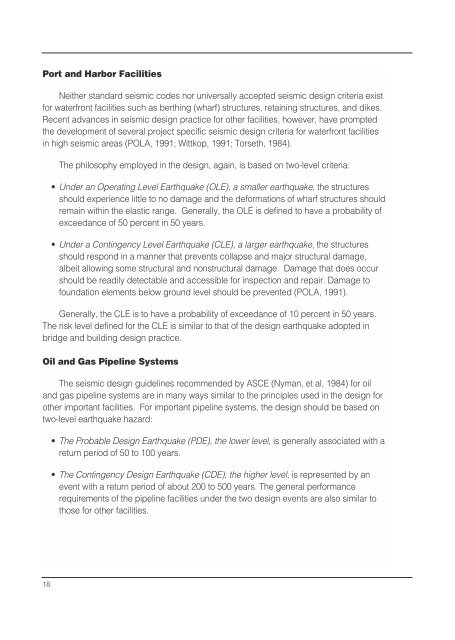Seismic Design of Tunnels - Parsons Brinckerhoff
Seismic Design of Tunnels - Parsons Brinckerhoff
Seismic Design of Tunnels - Parsons Brinckerhoff
Create successful ePaper yourself
Turn your PDF publications into a flip-book with our unique Google optimized e-Paper software.
Port and Harbor Facilities<br />
Neither standard seismic codes nor universally accepted seismic design criteria exist<br />
for waterfront facilities such as berthing (wharf) structures, retaining structures, and dikes.<br />
Recent advances in seismic design practice for other facilities, however, have prompted<br />
the development <strong>of</strong> several project specific seismic design criteria for waterfront facilities<br />
in high seismic areas (POLA, 1991; Wittkop, 1991; Torseth, 1984).<br />
The philosophy employed in the design, again, is based on two-level criteria:<br />
• Under an Operating Level Earthquake (OLE), a smaller earthquake, the structures<br />
should experience little to no damage and the deformations <strong>of</strong> wharf structures should<br />
remain within the elastic range. Generally, the OLE is defined to have a probability <strong>of</strong><br />
exceedance <strong>of</strong> 50 percent in 50 years.<br />
• Under a Contingency Level Earthquake (CLE), a larger earthquake, the structures<br />
should respond in a manner that prevents collapse and major structural damage,<br />
albeit allowing some structural and nonstructural damage. Damage that does occur<br />
should be readily detectable and accessible for inspection and repair. Damage to<br />
foundation elements below ground level should be prevented (POLA, 1991).<br />
Generally, the CLE is to have a probability <strong>of</strong> exceedance <strong>of</strong> 10 percent in 50 years.<br />
The risk level defined for the CLE is similar to that <strong>of</strong> the design earthquake adopted in<br />
bridge and building design practice.<br />
Oil and Gas Pipeline Systems<br />
The seismic design guidelines recommended by ASCE (Nyman, et al, 1984) for oil<br />
and gas pipeline systems are in many ways similar to the principles used in the design for<br />
other important facilities. For important pipeline systems, the design should be based on<br />
two-level earthquake hazard:<br />
• The Probable <strong>Design</strong> Earthquake (PDE), the lower level, is generally associated with a<br />
return period <strong>of</strong> 50 to 100 years.<br />
• The Contingency <strong>Design</strong> Earthquake (CDE), the higher level, is represented by an<br />
event with a return period <strong>of</strong> about 200 to 500 years. The general performance<br />
requirements <strong>of</strong> the pipeline facilities under the two design events are also similar to<br />
those for other facilities.<br />
18
















